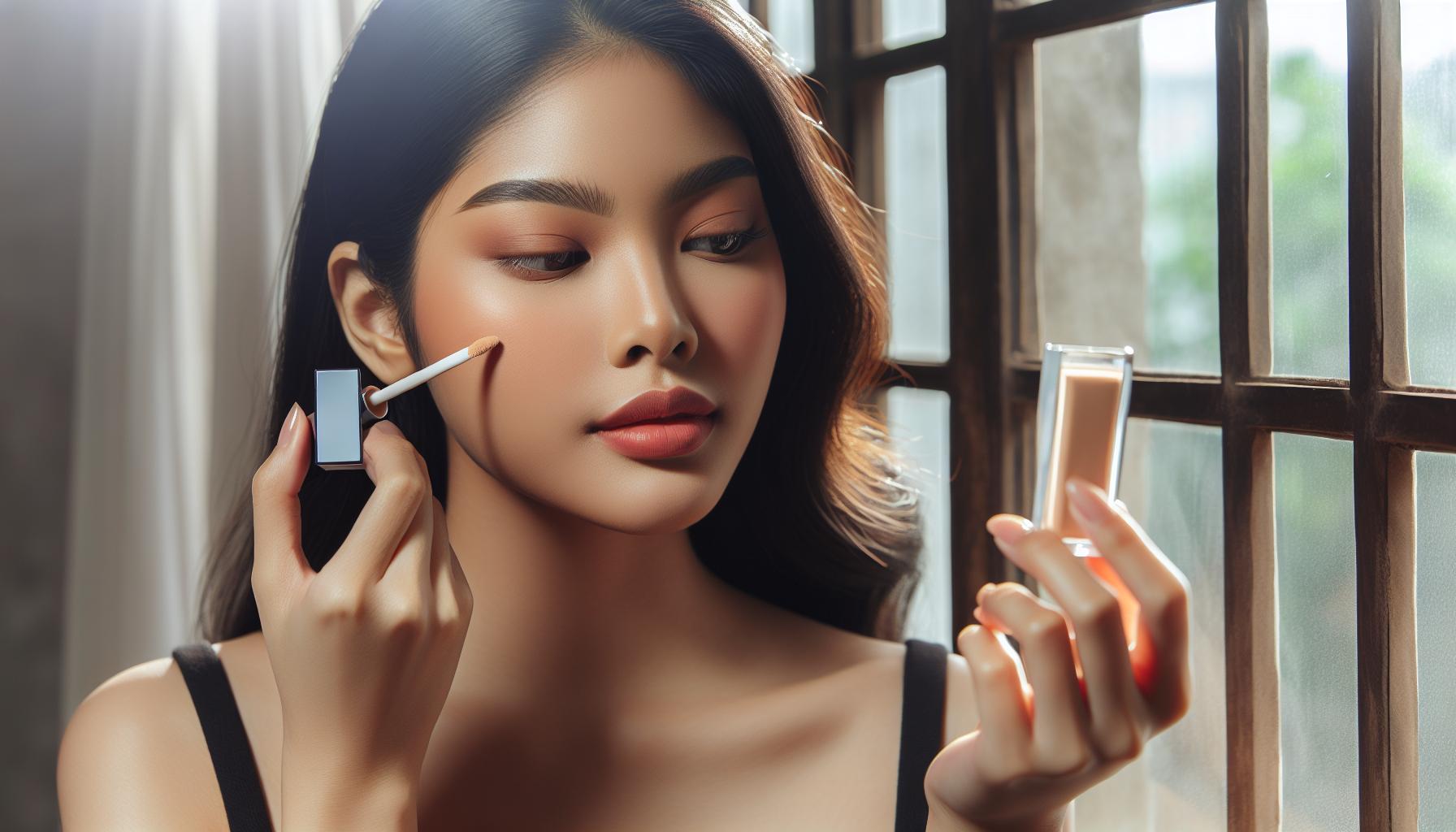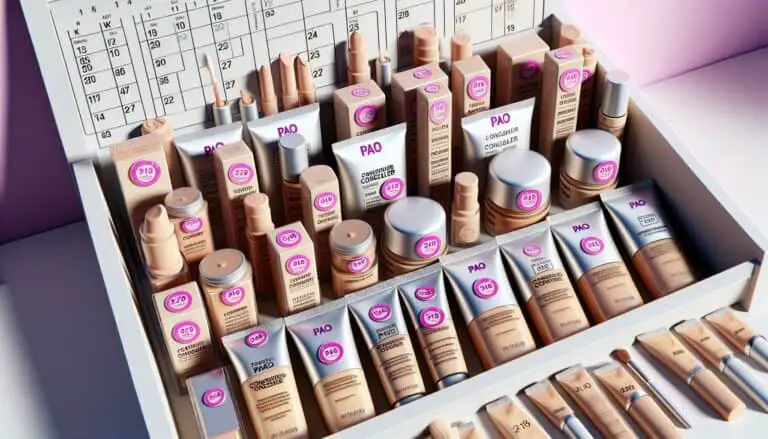DIY Tricks: How to Make Concealer Lighter Without a Lightening Product
Understanding Concealer Shades
Navigating through the world of concealer shades can be a tricky affair but with a little know-how, you’ll find your match. Skin undertone is a big player in this game. There are three main types: cool, warm, and neutral. Knowing yours is half the battle won.
Here’s a quick guide:
| Skin Undertone | Description |
|---|---|
| Cool | Pinkish, red, or bluish undertones |
| Warm | Yellow, peachy, or golden undertones |
| Neutral | A mix of both cool and warm undertones |
Remember, the goal of a concealer is not just to hide imperfections but to blend seamlessly with your skin, creating a flawless look. When your concealer is a tad too dark, it’s visible, creating an unwanted contrast.
“The right shade of concealer can make a huge difference. It’s not just about covering up; it’s about enhancing your natural beauty,” shares a top makeup artist.
But fret not, if you’ve already got a concealer that’s a shade too dark. Adjusting the shade at home is easier than you think. By mixing it with the right products – like a lighter foundation or a specialized shade adjuster – you can personalize the color to better match your skin tone. This DIY approach not only saves money but also empowers you to become your own makeup artist.
Evaluating Your Current Concealer Shade

Before you can lighten your concealer, it’s vital to accurately assess your current shade. The first step is understanding where it stands in relation to your natural skin tone. Is it just one shade too dark, or does it significantly contrast with your complexion? Knowing this will dictate how much adjustment is needed.
To evaluate, apply a small amount directly to the area you usually cover, such as under-eye circles or blemishes. Then, observe it in natural lighting because artificial lights can deceive the true mismatch.
Here’s a quick guide to help you determine how off your concealer shade might be:
| Situation | Assessment |
|---|---|
| Barely noticeable | 1 Shade Darker |
| Visible Contrast | 2-3 Shades Darker |
| Significantly Off | More than 3 Shades Darker |
Remember, the goal is for your concealer to disappear into your skin, not to highlight what you’re trying to conceal.
“The perfect concealer blend is invisible to the eye and feels like a second skin.”
Once you’ve pinpointed the disparity, the process of making your concealer lighter will be more precise. You might only need a slight adjustment or a more noticeable modification based on your initial assessment. Either way, tailoring the concealer to your exact needs is the key to achieving a flawless look.
Lightening Your Concealer with Foundation
Sometimes, the solution to your too-dark concealer problem is already in your makeup bag. Mixing your concealer with a lighter foundation can create the perfect shade without the need to purchase a new product. This technique not only saves money but also ensures a seamless match with your skin tone.
Step-by-Step Guide to Mixing
- Start Small: Begin with a tiny amount of concealer and slowly mix in an equally small amount of lighter foundation.
- Test and Adjust: Apply a small dab of the mixture to your jawline to check the color against your natural skin tone. Adjust the proportions as necessary.
- Blend Thoroughly: Mix the two products until the color is uniform. Avoid streaks or uneven tones.
“Perfecting your concealer shade is like mixing a custom potion for your skin. Precision and patience are key.”
Mixing Tips for Best Results
- Use a clean tool like a spatula or a back of a brush to mix.
- Opt for a matte foundation if your concealer is very oily, or vice versa, to maintain consistency.
- Experiment with liquid and cream foundations to see which formula blends best with your concealer.
| Benefit | Description |
|---|---|
| Cost-Effective | Avoids the expense of buying a new concealer. |
| Customized Shade | Achieves the perfect shade match for your skin. |
| Seamless Finish | Ensures the mixture blends invisibly with your skin. |
Remember, the goal is to lighten your concealer subtly to blend it perfectly with your natural skin tone. This method allows for the precise customization of your concealer’s shade.
Using a Lightening Product for Concealer
If you’ve ever found yourself with a concealer that’s just a tad too dark, there’s no need to fret. Besides the mixing method discussed earlier, using a lightening product specifically designed for makeup can be your savior. These products are formulated to adjust and lighten the shade of your base makeup without altering the texture or finish.
To start, you’ll need to choose a suitable lightening product. They typically come in liquid or cream form and are meant to be mixed with your concealer. Here’s a simple guide to get the right proportion:
| Product | Amount to Start With | Adjustment Notes |
|---|---|---|
| Concealer | 1 part | Base |
| Lightener | 1/4 part | Increase if necessary |
Remember, it’s always easier to add more lightener than to reverse the effect if you add too much. After getting the proportion right, mix the two products on a clean palette or the back of your hand using a mixing tool or your fingertip.
“Mixing makeup is like fine art; start with less, you can always add more,” says renowned makeup artist Alex Rivera.
The benefits are clear:
- Customizable shade
- Maintains the original texture and finish
- Effective and quick solution
When choosing a lightening product, opt for one that’s compatible with your concealer’s formula. Water-based products work well together, as do oil-based products. Mixing different bases might lead to an uneven texture or separation, so it’s vital to read the labels.
After achieving the perfect shade, apply the lightened concealer using your regular method. You’ll notice it blends seamlessly into your skin, offering the desired coverage without compromise.
DIY Hacks to Lighten Concealer
Sometimes, you might find yourself in a pinch without a lightening product at hand. Fortunately, there are a few DIY hacks to lighten concealer using items you likely already have at home.
One popular method involves mixing your concealer with a white foundation. This technique not only lightens the shade but also maintains the texture and finish of your concealer.
“Mixing white foundation with your concealer can achieve a perfect match to your skin tone while preserving the original quality of your makeup.”
Another effective DIY hack is using moisturizer to dilute the concealer. This not only lightens the shade but also adds hydration, making it a great option for dry skin types.
To give you an idea of proportions to start with, here’s a quick guide:
| Mix Ratio | Result |
|---|---|
| 1 part concealer to 1/2 part white foundation | Lightly lightened, maintains texture |
| 1 part concealer to 1/4 part moisturizer | Slightly lightened, added hydration |
Remember, it’s always best to start with smaller amounts and adjust as necessary. Mixing these in small steps ensures you don’t overdo the lightening effect and end up wasting product.
Each of these DIY methods offers a unique benefit, depending on your needs. Whether it’s maintaining the original texture, adding hydration, or achieving a customizable shade, there’s a DIY lightening hack for everyone. Be sure to test these mixtures on a small area of your skin to ensure the result meets your expectations before applying it to your face.
Conclusion
As you’ve seen, making your concealer lighter doesn’t require a trip to the store or an online order; you likely have everything you need right at home. Whether you’re using white foundation or a moisturizer to tweak the shade, remember that the key is in the mixing. Here’s a simple breakdown to help you get started:
| Ingredient | Starting Ratio | Application |
|---|---|---|
| White Foundation | 1 part foundation to 2 parts concealer | Mix well before applying |
| Moisturizer | 1 part moisturizer to 2 parts concealer | Test consistency on hand |
Remember: “Less is more when adjusting your concealer’s shade. You can always add, but you can’t take away.”
By incorporating these methods, not only are you customizing your makeup to your exact needs, but you’re also ensuring that your skin benefits from the additional hydration moisturizer can provide or maintaining the desired texture with the use of white foundation. The choice between these methods largely depends on what’s available to you and your skin’s needs.
Experimenting with the ratios mentioned above is a great way to start. However, everyone’s skin and makeup preferences are unique, so don’t be afraid to adjust the proportions. What works for one person might need a little tweaking for another. Always test the mixture on a small area of your skin to ensure the color and texture meet your expectations before applying it to your face. With a little patience and practice, you’ll find the perfect balance to achieve that flawless look.








